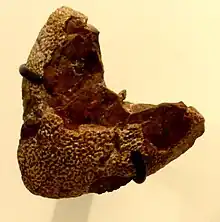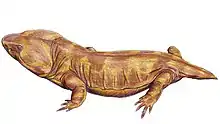Pantylus
Pantylus (from Greek: παν pan, 'all' and Greek: τύλος tylos, 'knob')[1] is an extinct lepospondyl amphibian from the Permian period of North America.

Pantylus cordatus
| Pantylus Temporal range: Early Permian | |
|---|---|
 | |
| Scientific classification | |
| Domain: | Eukaryota |
| Kingdom: | Animalia |
| Phylum: | Chordata |
| Clade: | †Recumbirostra |
| Family: | †Pantylidae |
| Genus: | †Pantylus Cope, 1881 |
| Species: | †P. cordatus |
| Binomial name | |
| †Pantylus cordatus Cope, 1881 | |
Pantylus was probably a largely terrestrial animal, judging from its well-built legs. It was about 25 centimetres (10 in) long, and resembled a lizard with a large skull and short limbs. It had numerous blunt teeth, and probably chased after invertebrate prey.[2]
References
- Miller, S. A. (Samuel Almond) (1877). The American Palaeozoic fossils : a catalogue of the genera and species, with names of authors, dates, places of publication, groups of rock in which found, and the etymology and signification of the words, and an introduction devoted to the stratigraphical geology of the Palæozoic rocks. Cincinnati, Ohio : The author. p. 324.
- Palmer, D., ed. (1999). The Marshall Illustrated Encyclopedia of Dinosaurs and Prehistoric Animals. London: Marshall Editions. p. 55. ISBN 1-84028-152-9.
This article is issued from Wikipedia. The text is licensed under Creative Commons - Attribution - Sharealike. Additional terms may apply for the media files.



